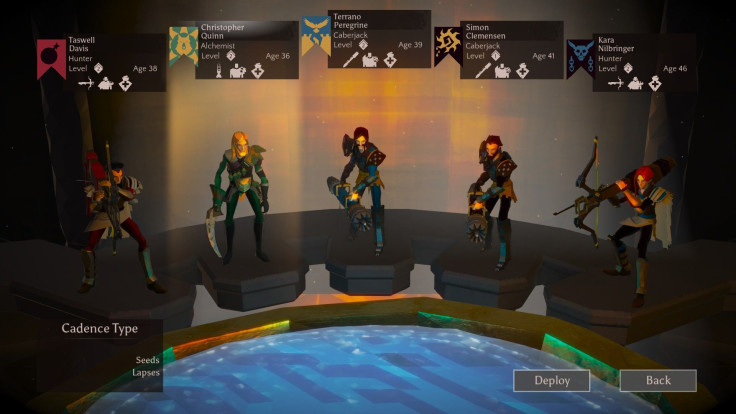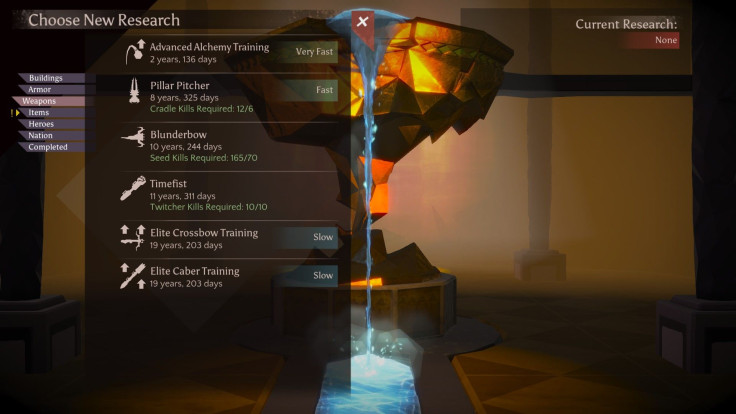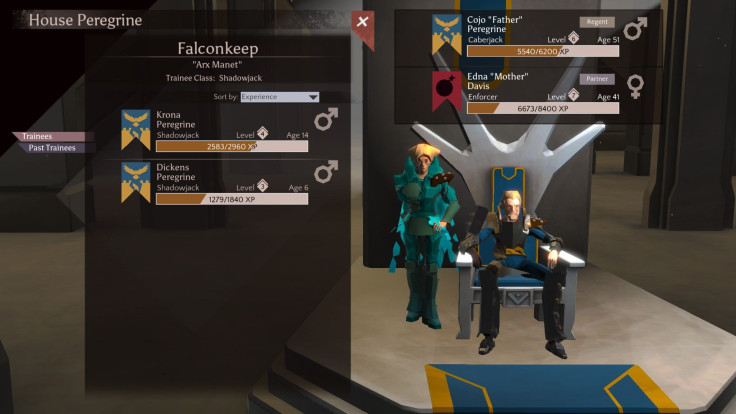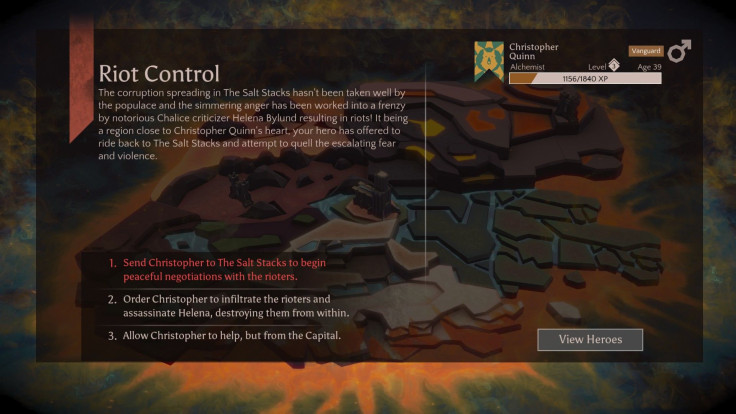Massive Chalice is easily one of the most-ambitious games to emerge from Double Fine, a studio known for trying to step outside the box with its projects, and I'm happy to report I'm thoroughly enjoying my time with Massive Chalice. There are moments that will make you question whether you care enough to finish the story. But those who do will find an incredibly engaging strategy game waiting for them; one that should make the wait for XCOM 2 a bit easier to deal with.
In Massive Chalice, players assume the role of a timeless ruler; one whose life is magically extended (via the Chalice) but who can no longer leave the keep in which the talking goblet resides. As king (or queen), it's your job to lead your people against the Cadence, a dark force that threatens to snuff out all life. The evil horde will conduct occasional raids on your lands, similar to the alien invasions from XCOM, and losing (or failing to respond) to an invading force will increase the corruption in a given region. Leave the corruption unchecked and you'll lose access to the area for the rest of your campaign.
Once the game is underway, the Massive Chalice experience can be divided into two halves. There's the combat portion of the game, which should immediately feel familiar to anyone who's played a few grid-based tactical-strategy games, and the kingdom management that fills the gaps between battles. But before you delve into either, you'll need to meet the first-generation of warriors under your command.

Players can choose their starting Houses manually or let the game assign them a random set of five that should still provide a well-rounded starter army. At first, you'll only have ten heroes to choose from when assembling a party for combat. But as the heads of each Houses begin to reproduce, it shouldn't take more than 15-20 years (in-game) for the list of warriors under your command to grow significantly. You just have to hope their offspring don't inherit any of their parents unwanted personality traits.
On the battlefield, players will lead their party against whatever combination of Cadence lackies invade a given region. Occasionally, you'll even be called upon to guard your keeps from forces large enough that the keep's ruling family will need to help repel the invaders. Heroes will gain experience from their kills, along with a few hundred points just for participating in the battle, and those who survive multiple engagements will quickly have the superior combat skills to prove it.
The Cadence seem to attack once every 15-20 years, giving you plenty of time to raise strategic buildings or research new gear for your party. Players will also need to make smart decisions about the future of each House -- more specifically, about the people left in charge of each House -- so that your kingdom's strongest bloodlines survive the 300-year long Massive Chalice campaign.
The battlefield isn't the only place where you'll determine the future of your kingdom, though. Massive Chalice also asks you to answers some of the questions that might be posed to a wartime king. Should we use these recovered parts to build better armor for our frontline troops or better weaponry for our ranged attackers? Should we focus on building a new keep, to increase the number of Houses fighting on behalf of our kingdom, or build a crucible to train our existing troops?

In some ways, it feels like Double Fine should've called its latest project The Lannister Simulator. Then again, I'm sure HBO and/or George R.R. Martin's legal team would've had a few things to say about such a decision. But that fact doesn't make the statement any less accurate. Massive Chalice gives you near-complete control over the growth of a kingdom, as well as its inhabitants, but also requires more than a few cracked eggs if you're ever hoping to see the credits roll.
In a bit of twist, the spirits residing inside the Chalice will coach you through these obstacles, frequently reminding you that none of your starting heroes (or their first generation of descendants) will be alive by the time the Massive Chalice campaign is over. It's these moments, sprinkled with just the right amount of levity, that make it easy to keep going after your favorite soldier(s) fall on the battlefield.
As much as I'm enjoying Double Fine's latest strategy game, I must point out that Massive Chalice is not without its issues. Thankfully, bugs and game crashes aren't anywhere close to as common with Massive Chalice as they are with most modern releases. But there are still plenty of headaches to be found over the course of the Massive Chalice campaign.
Let's start with the Trait system. Incredibly reminiscent of the genealogy mechanic from Rogue Legacy, heroes in Massive Chalice will develop a variety of character/personality traits over the course of their life. Some will be inherited from their parents, others picked up on the battlefield, and there are even a few traits that appear as a direct result of your decision-making. Some will have combat importance, like the handful of traits that let characters see further; however, there are a handful of traits that feel as though they should have been left out of the game.

Optimism and Pessimism are two of the traits I found most problematic, primarily because each effects the Chance To Hit percentages shown to players when attacking. I'm not opposed to tackling this aspect of human psychology but I do think Double Fine dropped the ball on its interpretation. Unlike Darkest Dungeon, which uses those traits to determine how a character will affect party morale, optimistic and pessimistic characters in Massive Chalice makes it difficult to make strategically sound attack decisions. Which can be incredibly problematic on the game's higher difficulty levels.
I'm also not a fan of Double Fine's decision to include a creature that saps experience from your heroes with every hit. We're not talking about a boss, either. Lapses make an appearance in Massive Chalice's first battle and seem to be one of the most commonly-encountered enemies in the game's campaign. There's even an advanced form that shows up during the later stages that deals more damage (and saps more XP) than its predecessor.
The problem is that Lapses don't seem to belong in a game that does its damnedest to simulate even the most minute aspects of the human experience. We're talking about a video game that outright lies to players about chance-to-hit percentages, in the name of representing general outlooks on daily life. So I don't understand why Double Fine would include a mechanic that suggests a glancing blow -- Lapses usually deal one or two points of damage per hit -- could make a person forget major life experiences.
Taking away XP immediately reduces your hero's combat prowess -- I've seen heroes lose multiple levels in a single combat round -- implying that the knowledge taken was acquired on the battlefield. And I'm about 99 percent certain that's not how amnesia works. In my limited experience, dealing with people whose brains are beginning to fail them, you don't just lose out on one aspect of your life. Everything goes. And you don't get it back by hitting a weird ghost that just hit you. Even considering the fantastical nature of the game, it feels like a bad mechanic; one of the few design elements I wouldn't mind seeing a modder strip out.

Massive Chalice Review - Final Verdict
Having launched at just $20, it would be hyperbolic to claim Double Fine's latest project didn't somehow justify the relatively meager amount of cash the studio is asking for a copy of Massive Chalice. The game may not be perfect but Massive Chalice lacks the launch-day woes frequently encountered with modern triple-A releases. More importantly, Massive Chalice offers an expanded take on the strategy genre that is likely to be copied by other independent studios (along with a few majors) in the coming years.
If strategy games aren't typically your thing, I don't expect Massive Chalice to be the game that changes your mind. A substantial portion of the experience might have nothing to do with grid-based battles but it's literally impossible to complete the game without fighting the Cadence. And you'll need to return to the battlefield pretty frequently over the course of the Massive Chalice campaign.
But if you've ever sank a few dozen hours into games like XCOM or The Banner Saga, I suspect Massive Chalice will be just the game you're looking for. Like any good strategy game, Massive Chalice is meant to be completed multiple times. Thanks to the game's escalating difficulty settings, including one that saves after every decision you make, Massive Chalice lets you scale its challenges to match your current skill level. And there's just enough variety in the randomly-occurring world events to keep Massive Chalice feeling fresh on your second (or third) go-round.
Massive Chalice embodies everything I love about tactical strategy games, right down to a desire for "just one more turn" that ultimately leaves me bleary-eyed and exhausted when the sun comes up and it's time to get ready for work. In fact, I've stopped writing this very review on multiple occasions, just to squeeze in a few more hours of Massive Chalice. And I'm not really sure what else you could ask for from a $20 game.


















